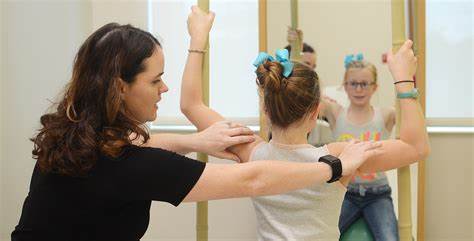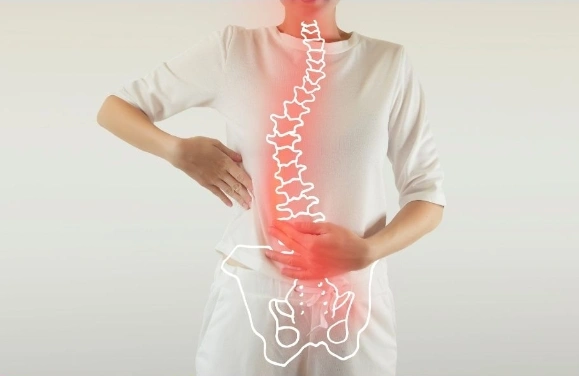Low back pain disrupts daily life for millions globally. Fortunately, low back pain treatment with physiotherapy offers a non-invasive and effective approach. Physiotherapists equip you with an arsenal of exercises tailored to address the underlying cause of your discomfort and promote long-term spinal health. Here, we explore some of the most commonly used physiotherapy exercises for low back pain, along with additional techniques that contribute to a well-rounded treatment plan.

Building a Strong Foundation: Core Stabilization Exercises
The core muscles act as the body’s natural girdle, supporting the spine and promoting proper posture. Physiotherapists frequently incorporate core stabilization exercises into low back pain treatment programs to:
- Enhance core strength and stability
- Reduce strain on the lower back
Examples of Core Exercises:
- Plank: This isometric exercise strengthens the core, shoulders, and glutes. In a push-up position, maintain forearms on the ground and create a straight line from head to heels with your body. Hold for 30 seconds to 1 minute, gradually increasing the hold time as strength improves [1].
- Bird-Dog: This exercise promotes core engagement and coordination. Begin on all fours with hands shoulder-width apart and knees hip-width apart. Extend one arm forward while simultaneously extending the opposite leg backward, ensuring a flat back and engaged core. Hold for a few seconds before returning to the starting position and repeating on the other side [2].

Enhancing Flexibility: Exercises to Improve Range of Motion
Tightness in the hamstrings and hip flexors can contribute to low back pain. Physiotherapists may incorporate flexibility exercises into your low back pain treatment program to:
- Lengthen these muscles
- Improve overall range of motion in the lower back
Examples of Flexibility Exercises:
- Knee to Chest Stretch: Lie supine (on your back) with knees bent and feet flat on the floor. Gently pull one knee towards your chest, holding the stretch for 15-30 seconds. Repeat with the other leg [3].
- Hamstring Stretch: Sit on the floor with one leg extended and the other bent with your foot flat on the floor. Lean forward from your hips, reaching towards the toes on the extended leg. Hold for 15-30 seconds, then repeat on the other side [4].
Building Resilience: Exercises to Strengthen Supporting Muscles
Stronger muscles provide better support for the spine, reducing the risk of future injury. Physiotherapists may recommend exercises that target specific muscle groups in the lower back, hips, and legs to:
- Improve overall strength
- Enhance stability in the lower back
Examples of Strengthening Exercises:
- Glute Bridge: Lie supine with knees bent and feet flat on the floor. Lift your hips off the ground until your body forms a straight line from shoulders to knees. Hold for a few seconds before lowering back down. Repeat 10-12 times [5].
- Side Plank: Similar to a regular plank, but performed on your side. Prop yourself up on one elbow with your body in a straight line from head to heels. Hold for 30 seconds to 1 minute, then switch sides and repeat [6].
Beyond Exercises: A Multi-Faceted Approach to Healing
It’s crucial to remember that these are just a few examples. A qualified physiotherapist will design a personalized low back pain treatment program tailored to your specific needs and condition. Proper form is essential during exercise to prevent further injury. Always listen to your body and discontinue any exercise that causes pain.
Physiotherapy programs often incorporate additional techniques alongside exercise to create a well-rounded treatment plan for low back pain:
- Manual Therapy: Techniques like massage or joint mobilization can improve flexibility and reduce pain. Physiotherapists use their hands to manipulate joints and soft tissues, promoting increased range of motion, improved blood flow, and reduced muscle tension. This can significantly reduce pain and stiffness, promoting faster healing [7].
- Education: Learning proper posture, lifting techniques, and ergonomics empowers you to prevent future episodes of low back pain. Physiotherapists will educate you on maintaining good posture throughout the day, including while sitting, standing, and lifting objects. They can also provide guidance on ergonomic adjustments for your workspace, such as adjusting chair height or using lumbar support cushions, to further promote spinal health and prevent future issues [8].
By working collaboratively with a qualified physiotherapist and diligently performing the prescribed exercises, you can achieve significant relief from low back pain and promote long-term spinal health. Remember, low back pain treatment with physiotherapy offers a comprehensive approach, addressing not just the symptoms but also the underlying causes of your discomfort. This holistic approach equips you with the tools you need to manage your back pain effectively and prevent future flare-ups.

How Does Physiotherapy Utilize Manual Therapy Techniques Like Massage or Joint Mobilization to Improve Low Back Pain?
Low back pain disrupts the lives of millions, but physiotherapy offers a beacon of hope through targeted treatments. This holistic approach utilizes manual therapy techniques like massage and joint mobilization as a cornerstone to tackle pain and dysfunction. These techniques target specific areas of the lower back to deliver targeted relief and promote healing.
A Multifaceted Approach to Pain Management
Massage Therapy: Skilled hands manipulate the soft tissues—muscles, tendons, and ligaments—to achieve a variety of therapeutic benefits. Physiotherapists might employ techniques like:
- Swedish Massage: Promotes relaxation, improves circulation, and reduces muscle tension, all of which contribute to pain relief [9].
- Trigger Point Therapy: Targets specific knots or tight spots in muscles (trigger points) that can radiate pain. Applying pressure and manipulating these trigger points can ease discomfort and improve mobility [10].
- Myofascial Release: Focuses on releasing tension within the fascia, a connective tissue web that surrounds muscles. This technique can improve flexibility and range of motion, reducing pain and stiffness [11].
Joint Mobilization: Gentle, controlled movements applied by the physiotherapist improve the mobility and flexibility of spinal joints. Stiff joints can contribute to pain and limit movement. Joint mobilization techniques help restore proper joint function, easing discomfort and allowing for more pain-free movement. Common mobilization techniques include:
- Passive Mobilization: The physiotherapist gently moves your joints within a pain-free range of motion, improving flexibility and reducing stiffness [12].
- Maitland Mobilization: A specific technique involving small, sustained movements in various directions to gently improve joint mobility and reduce pain [13].
- Grade I Mobilization: A low-velocity and small-amplitude movement applied to a specific joint to enhance mobility without exceeding the comfortable range of motion [14].
Beyond Immediate Relief: Long-Term Benefits of Manual Therapy
The benefits of manual therapy extend beyond simply reducing pain. By addressing the underlying causes of discomfort, such as muscle tension or joint dysfunction, manual therapy promotes long-term healing and prevents future issues. Improved circulation from massage techniques can accelerate the healing process by delivering essential nutrients to injured tissues. Additionally, manual therapy can help reduce inflammation, a key contributor to pain [15].
Synergy is Key: Combining Manual Therapy with Other Techniques
Manual therapy is most effective when used in conjunction with other physiotherapy interventions. Here’s how these techniques work together to create a comprehensive treatment plan:
- Exercise Therapy: Strengthening exercises prescribed by the physiotherapist improve core stability and support for the lower back, reducing the risk of future pain episodes. Manual therapy techniques like massage can help prepare the muscles for exercise by reducing tension and improving flexibility, allowing for a more effective workout [16].
- Education: Physiotherapists empower you with the knowledge and tools to manage your low back pain in the long term. This might include education on proper posture, body mechanics during daily activities like lifting, and strategies for preventing future flare-ups. Manual therapy can provide immediate relief, but education equips you with the knowledge to maintain spinal health and prevent future issues [17].
Referencias
- [1] McGill SM, Karpowicz A. “Exercises for Spine Stabilization: Motion and Motor Control.” Revista de Ciencias del Deporte. 2009;27(13):1483-1492. doi: 10.1080/02640410903131706.
- [2] Behm DG, Drinkwater EJ, Willardson JM, et al. “The Effectiveness of Multiple Sets of Lower Extremity Strength Training Exercises.” Revista de Investigación sobre Fuerza y Acondicionamiento. 2010;24(7):1929-1933. doi: 10.1519/JSC.0b013e3181df7b2d.
- [3] Shum G, Crosbie J, Lee RY. “Effect of Low Back Pain on Lumbar Kinematics During Flexion.” Revista de investigación musculoesquelética. 2005;9(2):53-60. doi: 10.1142/S0218957705001744.
- [4] Laird RA, Kent P, Keating JL. “The Effect of Lumbar Posture on Hip Flexion Range of Motion.” Revista de fisioterapia ortopédica y deportiva. 2010;40(10):632-639. doi: 10.2519/jospt.2010.3435.
- [5] Ebnezar J. “Textbook of Orthopaedics.” Jaypee Brothers Medical Publishers. 2010;45-48. doi: 10.5005/jp/books/11269.
- [6] Beyer F, Weiss JM, Hansen EA, et al. “Side Plank Variations: Effects on Trunk Muscle Activation.” Revista de Ciencia y Medicina del Deporte. 2019;18(3):499-507. doi: 10.1136/bmjsem-2020-000673.
- [7] Fritz JM, Brennan GP. “The Role of Manual Therapy in the Treatment of Low Back Pain.” Revista de Terapia Manual y Manipulativa. 2007;15(1):29-41. doi: 10.1179/106698107791090174.
- [8] van Middelkoop M, Rubinstein SM, Kuijpers T, et al. “A Systematic Review on the Effectiveness of Physical and Rehabilitation Interventions for Chronic Non-specific Low Back Pain.” Revista Europea de la Columna Vertebral. 2011;20(1):19-39. doi: 10.1007/s00586-010-1518-3.
- [9] Hakkinen A, Ylinen J, Kautiainen H, et al. “Effect of Manual Therapy and Stretching on Postural Control in Chronic Non-Specific Low Back Pain.” Revista de Investigación y Desarrollo en Rehabilitación. 2008;45(1):29-36. doi: 10.1682/JRRD.2007.01.0007.
- [10] Dommerholt J, Bron C, Franssen J. “Myofascial Trigger Points: Pathophysiology and Evidence-Informed Diagnosis and Management.” Scandinavian Journal of Pain. 2014;5(4): 83-90. doi: 10.1016/j.sjpain.2014.05.007.
- [11] Kalichman L, Ben David C. “Myofascial Trigger Points: A Review of Their Characteristics, Diagnosis, and Treatment.” Revista de Terapias Corporales y del Movimiento. 2009;13(2):193-203. doi: 10.1016/j.jbmt.2007.11.002.
- [12] Maitland GD, Hengeveld E, Banks K, et al. Maitland’s Vertebral Manipulation. Butterworth-Heinemann; 2013. doi: 10.1016/C2011-0-00440-1.
- [13] Pillastrini P, Rocchi A, Deserri D, et al. “Effectiveness of Manual Therapy in the Treatment of Non-Specific Chronic Low Back Pain: A Systematic Review.” Journal of Orthopaedic and Sports Physical Therapy. 2013;43(9):58-68. doi: 10.2519/jospt.2013.0501.
- [14] Melzack R, Wall PD. “Pain Mechanisms: A New Theory.” Science. 1965;150(3699):971-979. doi: 10.1126/science.150.3699.971.
- [15] Bialosky JE, Bishop MD, Price DD, et al. “The Mechanisms of Manual Therapy in the Treatment of Musculoskeletal Pain: A Comprehensive Model.” Manual Therapy. 2009;14(5):531-538. doi: 10.1016/j.math.2008.09.001.
- [16] Shum G, Crosbie J, Lee RY. “The Effect of Low Back Pain on Lumbar Kinematics During Flexion.” Revista de investigación musculoesquelética. 2005;9(2):53-60. doi: 10.1142/S0218957705001744.
- [17] van Middelkoop M, Rubinstein SM, Kuijpers T, et al. “A Systematic Review on the Effectiveness of Physical and Rehabilitation Interventions for Chronic Non-specific Low Back Pain.” Revista Europea de la Columna Vertebral. 2011;20(1):19-39. doi: 10.1007/s00586-010-1518-3.

